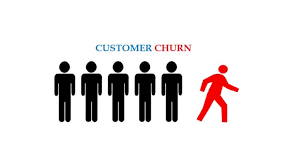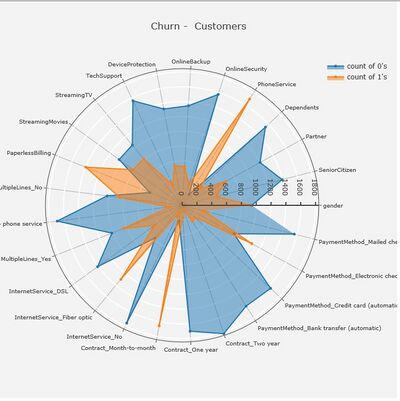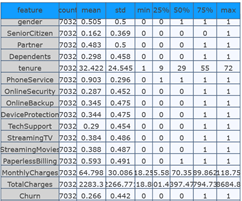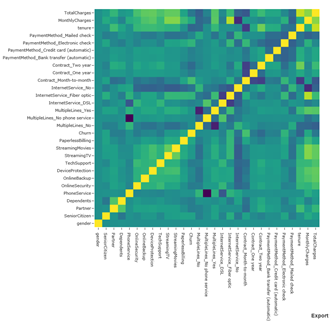Difference between revisions of "Group14 proposal"
| Line 38: | Line 38: | ||
| tenure || Number of months the customer has stayed with the company|| 1|| Numeric | | tenure || Number of months the customer has stayed with the company|| 1|| Numeric | ||
|- | |- | ||
| − | | PhoneService || Whether the customer has | + | | PhoneService || Whether the customer has a phone service or not (Yes, No) || No || Binary |
|- | |- | ||
| − | | MultipleLines || | + | | MultipleLines || Whether the customer has multiple lines or not (Yes, No, No phone service) || No phone service || Categorical |
|- | |- | ||
| InternetService || Customer’s internet service provider (DSL, Fiber optic, No) || DSL || Categorical | | InternetService || Customer’s internet service provider (DSL, Fiber optic, No) || DSL || Categorical | ||
Revision as of 11:21, 2 March 2020
Contents
Motivation and Objectives
Nowadays, all industries in the world are facing fierce competition. With the development of telecom technology and social media, the Telco companies play more and more important role in the society. There are growing number of wireless carriers in the world. The U.S has four main wireless carriers and lots of little wireless carriers. It is no surprise that the companies in this industry face very fierce competition. Since this condition, the most significant problem for these organizations are customer remaining. As we know, companies from these industries often have customer service department. Their target is that winning back clients who is churn. Because it is generally acknowledged that recovering long-term customers can be worth much more to a company than acquiring new customers.
In order to understand more directly the main factors that affect customer churn and better maintain the relationship with customers, relevant models will be built so as to select and visualize important variables. Lastly, we will present the comparison among models towards Recall, Accuracy, Precision and F1 score and evaluate the performances of different models.
Critique of Existing Visualization
This radar chart has all the variables from the dataset to be presented in a single graph. We can acknowledge that by different series (“0” as “No”, “1” as “Yes”), each variable their number of customers. However, even though this visualization has revealed plenty of valuable information, such as unbalanced data in several variables with a fair enough graph, some questions can be spotted from the graph. For instance, too many variables have presented on the chart at the same time. The best way to solve this problem is to use feature engineering, then to draw a new graph to visualize better the influence of different factors to churn or not churn.
Data Description
We collect the dataset from IBM Community. This dataset contains five spreadsheets. They contain the information about the demographics, location, population, services and status about customers. Demographic is the information about customers’ gender, age range, and if they have partners and dependents. Location is the information about customers’ detail location such as country, city. Status is the information about customers’ status of churn and the reason about churn. There are 7043 entity instances in the dataset. Each customer is identified by Customer_ID column. There are 42 columns with 40 attributes. Customers who left within the last month is the column named Churn_Value. The churn customers are recorded as 1 and the non-churn customers are recorded as 0.
| Data Fields | Description | Example | Datatype |
|---|---|---|---|
| Customer ID | Customer ID | 7590-VHVEG | Numeric |
| gender | Whether the customer is a male or a female | Female | Binary |
| SeniorCitizen | Whether the customer is a senior citizen or not (1, 0) | 0 | Binary |
| Partner | Whether the customer has a partner or not (Yes, No) | Yes | Binary |
| tenure | Number of months the customer has stayed with the company | 1 | Numeric |
| PhoneService | Whether the customer has a phone service or not (Yes, No) | No | Binary |
| MultipleLines | Whether the customer has multiple lines or not (Yes, No, No phone service) | No phone service | Categorical |
| InternetService | Customer’s internet service provider (DSL, Fiber optic, No) | DSL | Categorical |
| OnlineSecurity | Whether the customer has online security or not (Yes, No, No internet service) | No | Categorical |
| OnlineBackup | Whether the customer has online backup or not (Yes, No, No internet service) | No | Categorical |
| DeviceProtection | Whether the customer has device protection or not (Yes, No, No internet service) | No | Categorical |
| TechSupport | Whether the customer has tech support or not (Yes, No, No internet service) | No | Categorical |
| StreamingTV | Whether the customer has streaming TV or not (Yes, No, No internet service) | No | Categorical |
| StreamingMovies | Whether the customer has streaming movies or not (Yes, No, No internet service) | No | Categorical |
| Contract | The contract term of the customer (Month-to-month, One year, Two year) | Month-to-month | Categorical |
| PaperlessBilling | Whether the customer has paperless billing or not (Yes, No) | Yes | Binary |
| aymentMethod | The customer’s payment method (Electronic check, Mailed check, Bank transfer (automatic), Credit card (automatic)) | Electronic check | Categorical |
| MonthlyCharges | The amount charged to the customer monthly | 29.85 | Numeric |
| TotalCharges | The total amount charged to the customer | 29.85 | Numeric |
| Churn | Whether the customer churned or not (Yes or No) | No | Binary |
Methodology and Approach
In Feature engineering, we will generate variables from the previous ones and compose multiple features together, after which we will separate churn and not churn customer and separate categorical and numerical columns. The main point of this is selecting effective variables which would result in customer attrition. Apart from that, we may transform multi value variables to the dummy variable in the last step of this stage, we can obtain the variable summary like below:
Secondly, a correlation matrix of this model will be visualized to present the relationship among different variables and primarily understand the influence of each variables.
We intend to build four different models and visualize them and their performances: (1) In Logistic regression model performance, confusion matrix and receiver operating characteristic will be visualized to evaluate the performance of the Logistic regression model. Besides, we can get the variable importance while comparing all variables by bar chart. Furthermore, obtaining the appropriate threshold for logistic regression will also be visualized to understand what is beneath the model. (2) Synthetic minority oversampling Technique will be applied to build the advanced logistic regression, and we will try to form user portrait using the most important features which are selected from the model. (3) The decision tree will be generated refer to the results of the feature score and compare the GINI coefficient to measure the degree of inequality of the distribution. And we intend to use high-score categorical features to make a ternary plot to visualize the distribution of two groups. (4) In order to control over-fitting and improve the predictive accuracy, we will also build and visualize Random Forest Classifier and compare different trees. Lastly, we will visualize the comparison among four models towards Recall, Accuracy, Precision and F1 score and compare the performances of different models.
Proposed R Packages
Team Members
- Qiu Yang
- Shi Yawen
- Zhu Keyu
References



